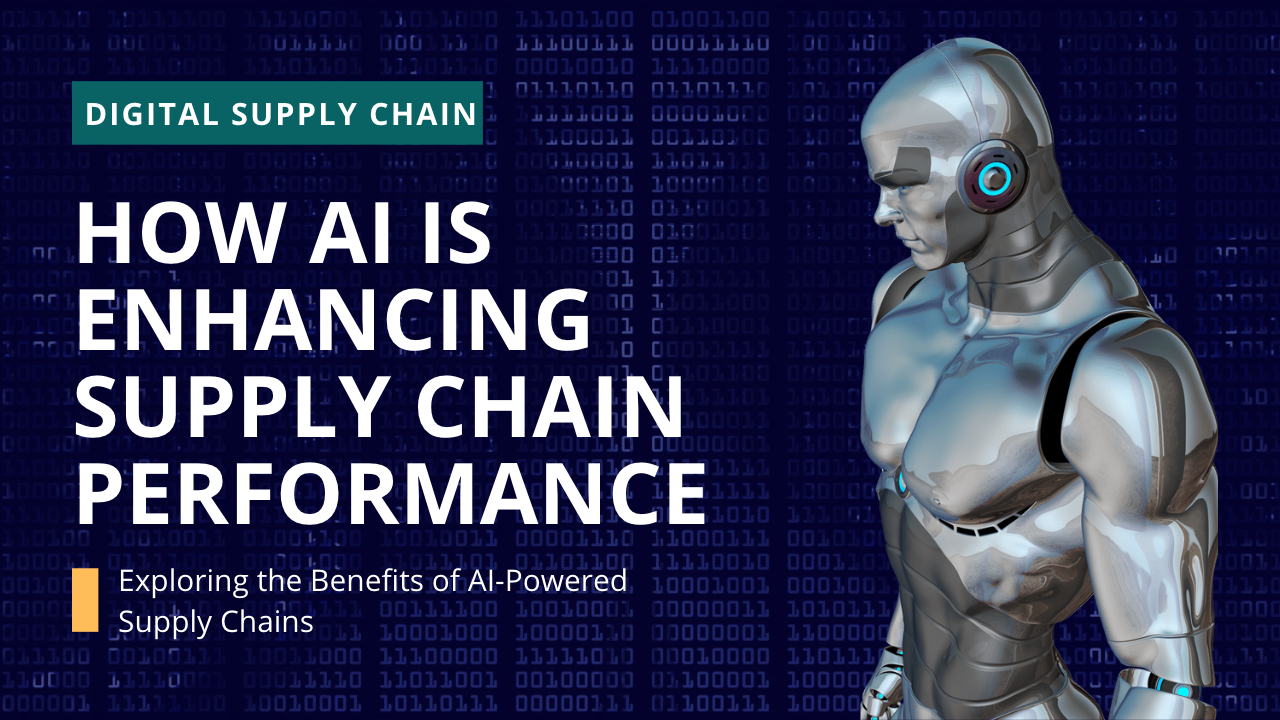Digital Supply Chain, Artificial Intelligence, the Internet of Things, and Automation is the Way Forward.
Supply Chain Management has undoubtedly progressed into the digital era, leading towards a more innovative future. With the integration of Artificial Intelligence, the Internet of Things, and Automation, digital supply chains are now surpassing human capabilities. This article delves further into how a company, on a global scale, implemented a successful digital supply chain and logistics network, exploring the various factors that contributed to its success.
Digitalisation in Supply Chains
With time, the world has been digitising. Businesses have followed suit and migrated from paper to digital formats to improve efficiency and reduce costs. The next step in this evolution is a “digital supply chain”- a connected system of enterprise systems that enable manufacturers to design, produce, deliver, and service products for customers with unprecedented speed and agility. Data collection and management are critical components of such a digital supply chain. In other words, it is collecting all relevant data about processes, condition monitoring/ assessment, and managing, analysing, and reporting on them throughout the entire process lifecycle. Collecting this data efficiently is critical for the traceability of raw materials through production processes. This involves the use of information technology tools as well as human expertise. In fact, for many years, the journal was a testbed for pioneering work in AI and robotics. The first issue included articles on artificial intelligence, machine learning, computational linguistics, multi-agent systems, robotics, autonomous vehicles, and un-crewed aerial vehicles (UAV). It also covered cognitive computing, big data analytics, cloud computing and internet-of-things applications.
Importance of Digital Supply Chain Management
The digital supply chain is now one of the most important aspects of any company. The digital supply chain has impacted companies by improving efficiencies, access to goods and information, and reducing costs. It allows for quick response to market demands, inventory management, and responsiveness to threats. The digital supply chain can be used to enhance operations during manufacturing and distribution, but it can also help firms during their procurement activities. Most importantly, it helps reduce errors and improve quality while enabling fast and accurate inspection of goods before they are shipped.
Cyber-physical system
The future of digital supply chains is now. Soon, manufacturing will be done on a micro-scale and rapidly with augmented capabilities. 3D printing has already revolutionised how we produce parts, but now this technology is making strides in other aspects of manufacturing. On-demand manufacturing will allow an infinite number of variations to be built in real-time. Customers can order anything they want without waiting or worrying about supply issues. This is expected to change how consumers purchase products and services. Companies will no longer have to wait until demand increases to expand production because they can create what customers need when they need it. They will only make what they sell and then sell that exact item again. There will still be some stability in the manufacturing sector because there will always be a need for manufactured items. However, the industry will see more shifts toward flexible manufacturing, which means businesses will often have minimal resources. Manufacturing companies that don’t adapt to these changes could lose out completely. They must adopt technologies like the Internet of Things (IoT) and blockchain into their processes.

Electronic Commerce
For many years, the way we buy and sell goods has been limited to human involvement. Still, with the advent of the digital supply chain–which combines information and communication technology to enable collaborative value chains–, the future is now. Digital Supply Chain combines IT systems with physical components worldwide to achieve global visibility and collaboration between buyers and sellers within any business. The internet makes buying from anywhere fast and easy, so why not do away with all the intermediaries involved in traditional supply chains?
Benefits of a Digital Supply Chain
The answer may surprise you. With digital supply chains, suppliers and manufacturers can collaborate in real-time to quickly respond to demand, reduce costs and increase quality. Digital technologies such as enterprise resource planning (ERP) and artificial intelligence (AI) automate business processes and eliminate inefficiencies that result from manual data entry into spreadsheets or databases. This results in significant cost savings across industries. Companies that implement digital supply chains also experience higher levels of customer satisfaction due to shorter lead times on delivery and shipping.
There are multiple ways organisations can benefit from having a digital supply chain. Firstly, it brings transparency between buyers and sellers. Because all transactions are done digitally, it is easy to see where products come from and how much they cost. This information allows companies to make better purchasing decisions and reduce fraudulent purchases. It also means that when there is a problem with a product, such as quality issues or non-delivery, consumers have more opportunities to communicate directly with the seller, which helps improve trust and customer satisfaction.
Furthermore, since all data is collected electronically, businesses can easily access this information online and create reports on consumer behaviour and spending habits. Companies can then use this information to target advertisements to ensure they reach the right audience. Lastly, blockchain technology enables tracking and managing inventory throughout its life cycle. This is important because, according to the Global Industry Analysts Company Report by Goldman Sachs (2019), global retail sales will increase from $3 trillion to 4 trillion by 2025.
Adopting a Digital Supply Chain
Nowadays, most businesses are incorporating digital supply chains into their operations. The fact that the future is now is the biggest reason for this. The digital supply chain allows companies to be more agile and nimble in an ever-changing marketplace, giving them an edge in the market against competitors who are not adapting to this new way of doing business. Therefore, companies must understand what they need to do to move toward a digital supply chain before it becomes too late. Here are three things you need to consider when deciding whether your company should become part of the movement toward digital supply chains:
- Understand current or potential problems – Before making any decisions about adopting a digital supply chain, you must first identify possible barriers to changing. These might include logistics, technology, communication, human resources, process management, security and legal issues. Once these have been identified, you will know where exactly you need to start fixing the problem.
- Identify technological solutions – There are many ways companies can incorporate digital supply chains in their operations. Some use existing technologies such as barcodes and RFID tags, while others integrate web APIs directly into their systems. However, there are other more innovative options like using blockchain to track goods and monitor shipments. It is also essential to ensure that businesses know how third parties could use data. This means being thoughtful about your personal information on customers and employees.
- Choose the right partner – Once you’ve decided that moving towards a digital supply chain is worth considering, choosing a digital supplier may seem overwhelming. To help with this, we’ve put together an infographic highlighting different types of suppliers available online today. The graphic will showcase various e-commerce sellers, from marketplaces to dedicated managed service providers.
Challenges in Implementing a Digital Supply Chain
Implementing a digital supply chain is becoming essential to the logistics industry. With increasing competition, there are many barriers to implementation, but some companies are still forging ahead to reap the benefits of this new system. The first challenge is measuring the value the digital supply chain can bring to their business and see what would be necessary for them to implement it. Additionally, they need to identify whether their current technology infrastructure is enough to support the digital supply chain workflow and whether they should look at merging with another company that already has this implemented.
How do we get there?

Every business knows they need to modernise their supply chain, but many are unsure where to start. The key is using technology to your advantage. Research shows that by 2022, 85% of global manufacturing will be done on 3D printing machines, while the rest will be outsourced. Businesses must keep up with these advances to stay competitive. You must consider how much time, money, and resources you’re willing to dedicate to implementing a viable solution. You don’t want to invest all your time and energy into something complex when you could just as easily spend that time looking into other business areas. Consider what you need to make this transition successful, from employee training to investment in equipment.
Conclusion
Digital supply chains will disrupt the status quo and dramatically change our lives and work. Most importantly, its adoption is imperative. Many organisations now understand that the digital supply chain offers significant cost savings internally and externally. They must find ways to embrace new technology — including blockchain solutions – to improve efficiency within their organisation.
The idea behind the digital supply chain is to take advantage of and implement strategies and tactics that will optimise the various levels of the supply chain, including purchasing and distribution. This can be adopted by almost any type of business because it means that they will be more efficient in operating their businesses by covering all aspects of this sector. An excellent example is Amazon, which has created a single platform that covers every part of its business, giving customers access to products, services, price information and reviews across all its channels.





